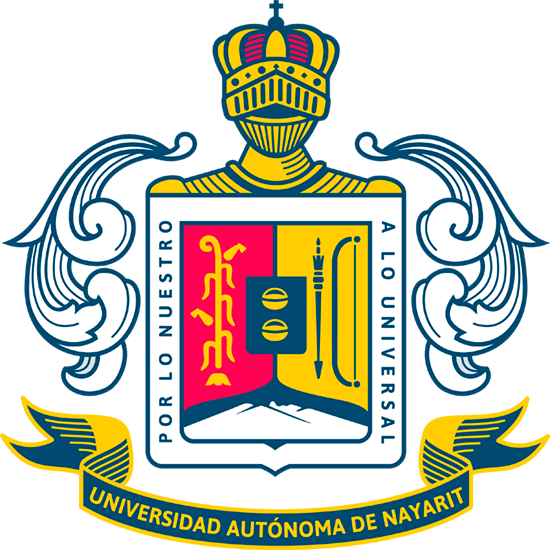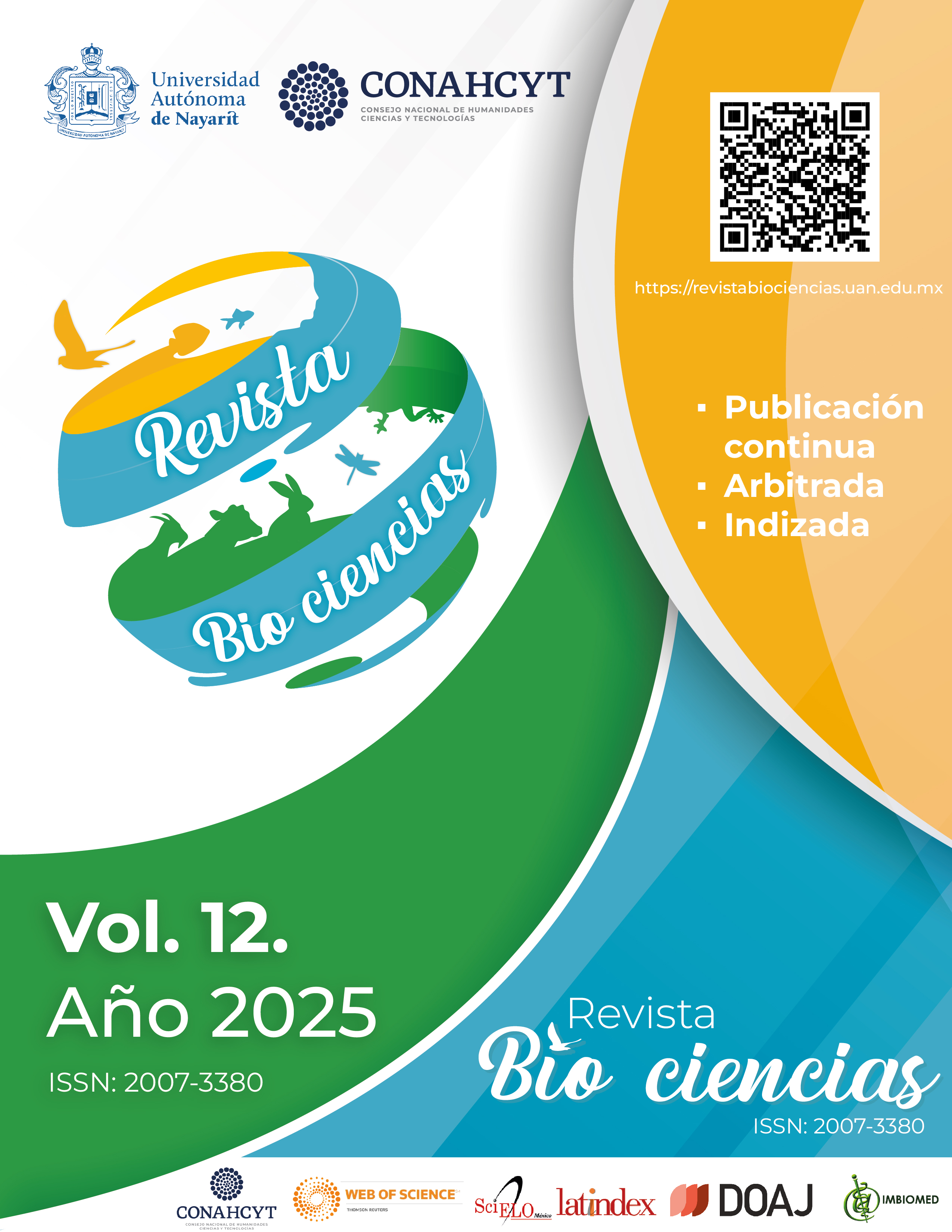Resumen
Frankliniella occidentalis (Pergande) es la plaga más importante en el cultivo de limón mexicano en Michoacán, y su combate se basa en la utilización de insecticidas de amplio espectro; sin embargo, hoy en día, las poblaciones de trips son constantes en los huertos. Para comprender cómo las condiciones climáticas influyen en la dinámica poblacional la plaga y sus enemigos naturales, se correlacionó durante cuatro años la densidad de la población de trips (Thysanoptera: Thripidae) y sus enemigos naturales con la temperatura (mínima, media y máxima) y la precipitación. Se encontró correlación positiva entre la densidad poblacional de F. occidentalis con la temperatura media y máxima, y una correlación positiva entre la densidad poblacional de los enemigos naturales con la precipitación y la temperatura mínima. Estos resultados resaltan el impacto de los factores ambientales en la regulación de las poblaciones de trips y los organismos benéficos. Con base en nuestros resultados habrá un mayor aumento de las poblaciones de trips y disminución de las poblaciones de insectos benéficos en la zona citrícola del Valle de Apatzingán. Se requiere cambiar el manejo fitosanitario actual, por un manejo integral que fortalezca el papel de los enemigos naturales en el control de plagas.
Citas
Ahmad-Ur-Rahman Saljoqi, N. A., Khan, J., Ehsan-ul-Haq, S., Rehman, Z. H., Saeed, H. G., Nadeem, M. S., & Zada, H. (2015). The impact of temperature on biological and life table parameters of Chrysoperla carnea Stephens (Neuroptera: Chrysopidae) fed on cabbage aphid, Brevicoryne brassicae (Linneaus). Journal of Entomology and Zoology Studies, 18, 265-288. https://www.entomoljournal.com/archives/2015/vol3issue2/PartE/63-402.pdf
Bale, J. S., Masters, G. J., Hodkinson, I. D., Awmack, C., Bezemer, T. M., Brown, V. K., Butterfield, J., Buse, A., Coulson, J. C., Farrar, J., Good, J. E. G., Harrington, R., Hartley, S., Jones, T. H., Lindroth, R. L., Press, M. C., Symrnioudis, I., Watt, A.D. & Whittaker, J. B. (2002). Herbivory in global climate change research: Direct effects of rising temperature on insect herbivores. Global Change Biology, 8(1), 1-16. https://doi.org/10.1046/j.1365-2486.2002.00451.x
Blanco, Y., & Leyva, A. (2007). Las arvenses en el agroecosistema y sus beneficios agroecológicos como hospederas de enemigos naturales. Cultivos tropicales, 28(2), 21-28. https://www.redalyc.org/pdf/1932/193217731003.pdf
Cédola, C., & Polack, A. (2011). Primer registro de Amblyseius swirskii (Acari: Phytoseiidae) en Argentina. Revista de la Sociedad Entomológica Argentina, 70(3-4), 375-378. https://www.redalyc.org/comocitar.oa?id=322028524024
Chingal, J. P. C., Belalcázar, G. C., & Ortega, J. A. S. (2016). Influencia de la temperatura sobre el ciclo de vida de la especie necrofaga Compsomyiops arequipensis Mello, 1968 (Diptera: calliphoridae). Revista de la Asociación Colombiana de Ciencias Biológicas, 1(28), 105. https://revistaaccb.org/r/index.php/accb/article/view/119
Comisión Nacional del Agua. (2024). Datos climatológicos de México por Municipio. https://smn.conagua.gob.mx/es/pronostico-del-tiempo-por-municipios
Contreras, J., Pedro, A., Sánchez, J. A., & Lacasa, A. (1998). Influencia de las temperaturas extremas en el desarrollo de Frankliniella occidentalis (Pergande)(Thysanoptera: Thripidae). Boletin Sanidad Vegetal, Plagas, 24, 251-266. https://www.mapa.gob.es/ministerio/pags/Biblioteca/Revistas/pdf%5Fplagas%2FBSVP%2D24%2D02%2D251%2D266.pdf
Desneux, N., Decourtye, A., & Delpuech, J. M. (2007). The sublethal effects of pesticides on beneficial arthropods. Annual Review of Entomology, 52, 81-106. https://doi.org/10.1146/annurev.ento.52.110405.091440
Domínguez-Sarmiento, C. & A. Jaramillo-Moreno. (2024). [Boletín]. El Fortalecimiento del Sistema de Alerta Temprana Para Ciclones Tropicales (SIAT-CT) ante un Clima Cambiante. Academia Mexicana de Impacto Ambiental. 82,11-15. https://amia.org.mx/wp-content/uploads/2024/04/Boletin-Amia-82r.pdf
Evans, J. D. (1996). Straightforward statistics for the behavioral sciences. Thomson Brooks/Cole Publishing Co.
Gao, Y., Ding, N., Wang, D., Zhao, Y. J., Cui, J., Li, W. B., & Shi, S. S. (2022). Effect of temperature on the development and reproduction of Thrips flavus (Thysanoptera: Thripidae). Agricultural and Forest Entomology, 24(3), 279-288. https://doi.org/10.1111/afe.12491
González, G. (2006). Los Coccinellidae de Chile. http://www.coccinellidae.cl
Guerrero-Carrera, J., Jaramillo-Villanueva, J. L., Mora-Rivera, J., Bustamante-González, Á., Vargas-López, S., & Chulim-Estrella, N. (2020). Impacto del cambio climático sobre la producción de café. Tropical and Subtropical Agroecosystems, 23(71), 1-18. http://dx.doi.org/10.56369/tsaes.3288
Hardwick-Jones, R., Westra, S., & Sharma, A. (2010). Observed relationships between extreme sub‐daily precipitation, surface temperature, and relative humidity. Geophysical Research Letters, 37(22). https://doi.org/10.1029/2010GL045081
Hódar, J. A., Zamora, R., & Cayuela, L. (2012). Cambio climático y plagas: algo más que el clima. Ecosistemas, 21(3), 73-78. https://doi.org/10.7818/ECOS.2012.21-3.09
Jalali, M. A., Tirry, L., & De Clercq, P. (2009). Effects of food and temperature on development, fecundity and life‐table parameters of Adalia bipunctata (Coleoptera: Coccinellidae). Journal of Applied Entomology, 133(8), 615-625. https://doi.org/10.1111/j.1439-0418.2009.01408.x
José-Pablo, R. (2014). La Crisopa Ceraeochrysa valida: recurso local con potencial de depredación contra el psílido asiático de los cítricos [Tesis de Maestría, Colegio de Postgraduados]. http://colposdigital.colpos.mx:8080/xmlui/handle/10521/2895
Miranda-Salcedo, M.A., E. Loera-Alvarado & E. Cortez-Mondaca. (2019). Interacción de trips (Thysanoptera: Thripidae) y sus enemigos naturales en limón mexicano, en Michoacán. (Memoria de congreso). Memoria XLII Congreso Nacional de Control Biológico, Veracruz, Ver. 71-75 pp. https://drive.google.com/file/d/1pXX8OmiN-okiq4TzPd-IMGErvO6j5jjA/view
Mouden, S., Sarmiento, K. F., Klinkhamer, P. G., & Leiss, K. A. (2017). Integrated pest management in western flower thrips: past, present and future. Pest management science, 73(5), 813-822. https://doi.org/10.1002/ps.4531
Mound, L.A. (1997). Biological Diversity. In: Thrips as Crop Pests, edited by T. Lewis. CAB International, Wallingford, UK. 197-215.
Mound, L.A., &Teulon D.A. (1995). Thysanoptera as phytophagous opportunists. In Thrips biology and management. Boston, MA: Springer US. 3-19.
Murillo-Hernández, J. E., Illescas-Riquelme, C. P., López-Lima, D., & Manzanilla-Ramírez, M. Á. (2022). Incidencia y Daños de Scirtothrips dorsalis en Plantaciones de Limón Mexicano en Colima, México. Southwestern Entomologist, 47(1), 211-214. https://doi.org/10.3958/059.047.0120
Murray-Tortarolo, G. N. (2021). Seven decades of climate change across Mexico. Atmósfera, 34(2), 217-226. https://doi.org/10.20937/atm.52803
National Aeronautics and Space Administration [NASA]. (2025). Global Temperature. En línea: (https://climate.nasa.gov/vital-signs/global-temperature/?intent=121
Parry, M. L., Rosenzweig, C., Iglesis, A., Livermore, M. & Fisher, G. (2004). Effects of climate change on global food production under SRES emissions and socio-economic scenarios. Global Environmental Change, 14 (1), 53-67. https://doi.org/10.1016/j.gloenvcha.2003.10.008
Platero, G. G. R. (2015). Cambio Climático y Plagas Agrícolas. (Conference Paper). Foro Nacional de Cambio Climático. Managua, Nicaragua. https://www.researchgate.net/profile/Gonzalo-Galileo-Rivas-Platero/publication/278410790_Cambio_climatico_y_plagas_agricolas/links/55809f4f08ae607ddc322719/Cambio-climatico-y-plagas-agricolas.pdf.
Régnière, J., Powell, J., Bentz, B., & Nealis, V. (2012). Effects of temperature on development, survival and reproduction of insects: Experimental design, data analysis and modeling. Journal of Insect Physiology, 58(5), 634-647. https://doi.org/10.1016/j.jinsphys.2012.01.010.
Sáenz-Romero, C., Rehfeldt, G. E., Crookston, N. L., Duval, P. & Beaulieu, J. (2009). Estimaciones de cambio climático para Michoacán: Implicaciones para el sector agropecuario y forestal y para la conservación de la Mariposa Monarca. Consejo Estatal de Ciencia y Tecnologıa de Michoacán, México. https://www.fs.usda.gov/rm/pubs_other/rmrs_2009_saenz_romero_c001.pdf
SAS Institute. 2013. The Complete Guide to the SAS Output Delivery System: Version 9.4 SAS Institute Inc., Cary.
SIAP (Servicio de Información Agroalimentaria y Pesquera) (2024). Avances de Siembras y Cosechas. En línea: https://nube.siap.gob.mx/avance_agricola/.
Soto-Rodríguez, G. A., Rodríguez-Arrieta, J. A., González Muñoz, C., Cambero-Campos, J., & Retana-Salazar, A. P. (2017). Clave para la identificación de géneros de Thrips (Insecta: Thysanoptera) comúnmente asociados a plantas ornamentales en Centroamérica. Acta zoológica mexicana, 33(3), 454-463. https://doi.org/10.21829/azm.2017.3331146
Valencia-Luna, L. A., Romero-Nápoles, J., Valdez-Carrasco, J., Carrillo-Sánchez, J. L., & López-Martínez, V. (2006). Taxonomía y registros de Chrysopidae (Insecta: Neuroptera) en el estado de Morelos, México. Acta zoológica mexicana, 22(1), 17-61. https://doi.org/10.21829/azm.2006.2211959
Vázquez, L. L., Alfonso, J., Matienzo, Y., & Veitía, M. (2008). Conservación y manejo de enemigos naturales de insectos fitófagos en los sistemas agrícolas de Cuba. (pp. 198-198). Ed. CIDISAV. https://www.researchgate.net/profile/Luis-Vazquez-50/publication/268981130_Conservacion_y_manejo_de_enemigos_naturales_de_insectos_fitofagos_en_los_sistemas_agricolas_de_Cuba/links/566c692208aea0892c4fc59d/Conservacion-y-manejo-de-enemigos-naturales-de-insectos-fitofagos-en-los-sistemas-agricolas-de-Cuba.pdf

Revista Bio Ciencias por Universidad Autónoma de Nayarit se encuentra bajo una Licencia Creative Commons Atribución-NoComercial-SinDerivadas 4.0 Unported.
Basada en una obra en http://biociencias.uan.edu.mx/.
Permisos que vayan más allá de lo cubierto por esta licencia pueden encontrarse en http://editorial.uan.edu.mx/index.php/BIOCIENCIAS.licencia de Creative Commons Reconocimiento-NoComercial-SinObraDerivada 4.0 Internacional






